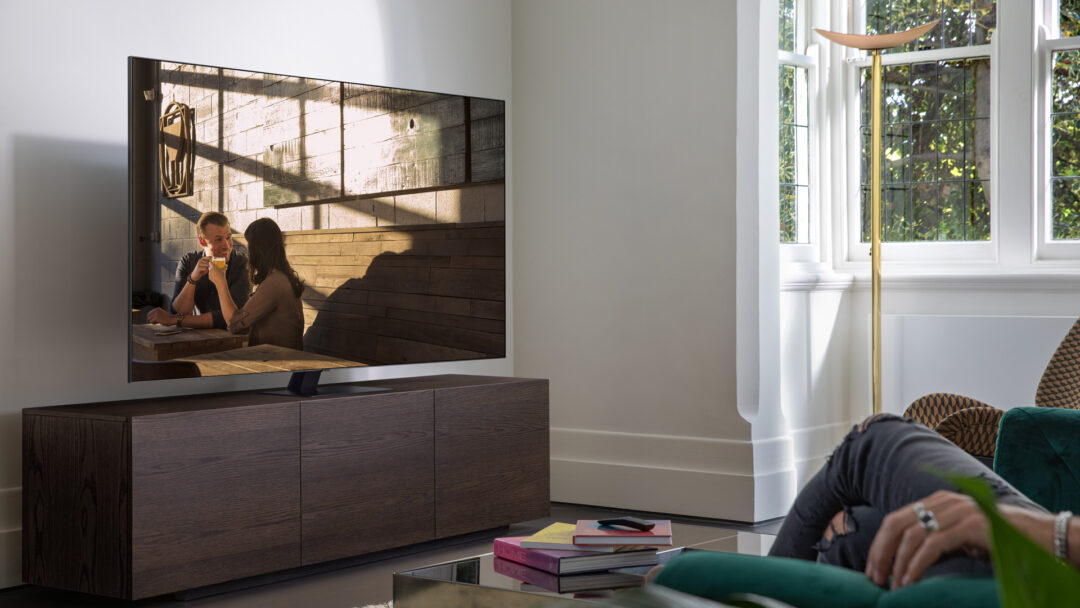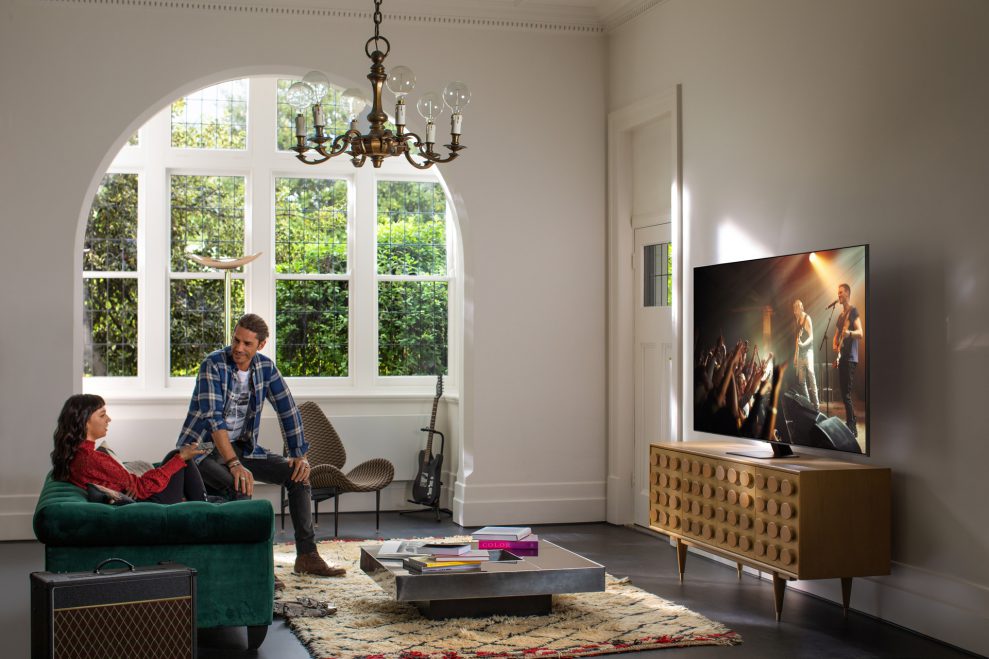After being in “eighth heaven” with Samsung’s new 8K TV until recently, it’s time to get down to earth again. While 8K resolution may look very impressive in all its razor-sharp splendor, few people are willing to pay for the party! Many will probably claim that it is crazy to spend 40-50,000 kroner on a TV – especially in these times where you may be extra careful about what the kroner goes to. Fortunately, there are some great options!
If you are picky about picture quality, but are reluctant to pay more than you have to, the 4K model Samsung Q80T comes exactly as ordered. This QLED display features much of the same technology found in Samsung’s flagship models, only at a much nicer price. Who knows, maybe it’s possible to get top performance without turning personal finances upside down?
Samsung Q80T: QLED TV with direct LED
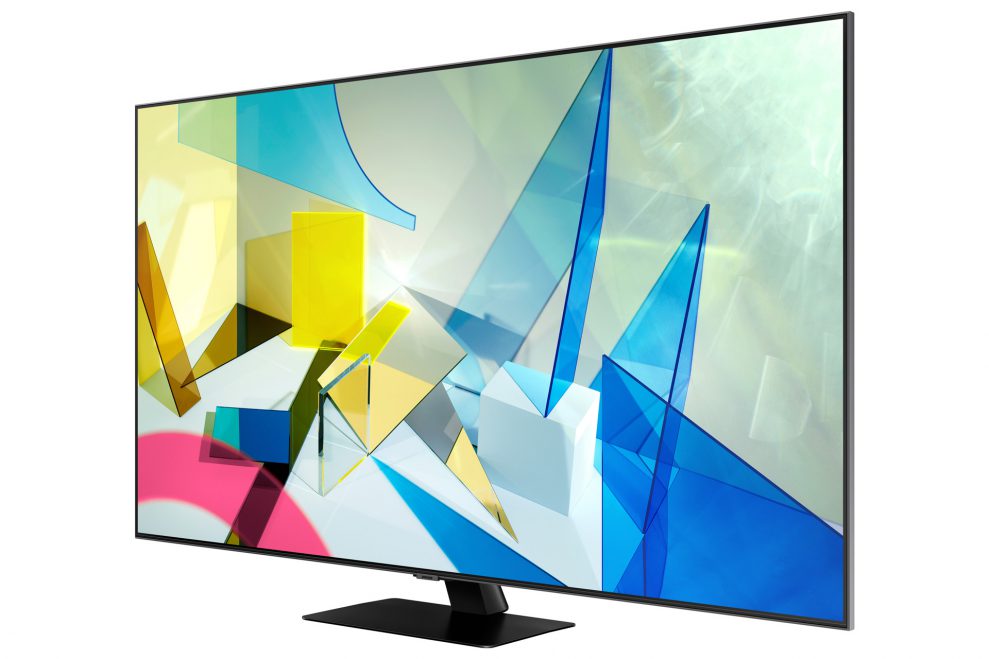
The Q80T is a recent newcomer among the 2020 models from Samsung. Based on the name, it is easy to believe that we are talking about a direct successor to last year’s Q80R. But then no! The Koreans have changed the model solitaire this year, and therefore this year’s “Q80T” is more similar to last year’s Q70R in terms of technical specifications. Understand the one who can…
Regardless, the Q70R is no stupid TV to take over the baton after: This is the model we named the best buy among the QLED models last year. For the 2020 model year, the Q80T is now the cheapest QLED variant with direct LED taillights, which means a marked improvement in image quality. Lower models on the ladder such as the Q77T, Q60T – yes even the design model The Frame – have to settle for edge LEDs.
Direct LED taillights are a technique we know from Samsung high-end models. Admittedly, the Q80T has fewer individual LED zones, and slightly lower brightness than the rawest top models. That said, we were quite impressed with what this Samsung screen achieves, and that at half the price of the big brothers!
Design
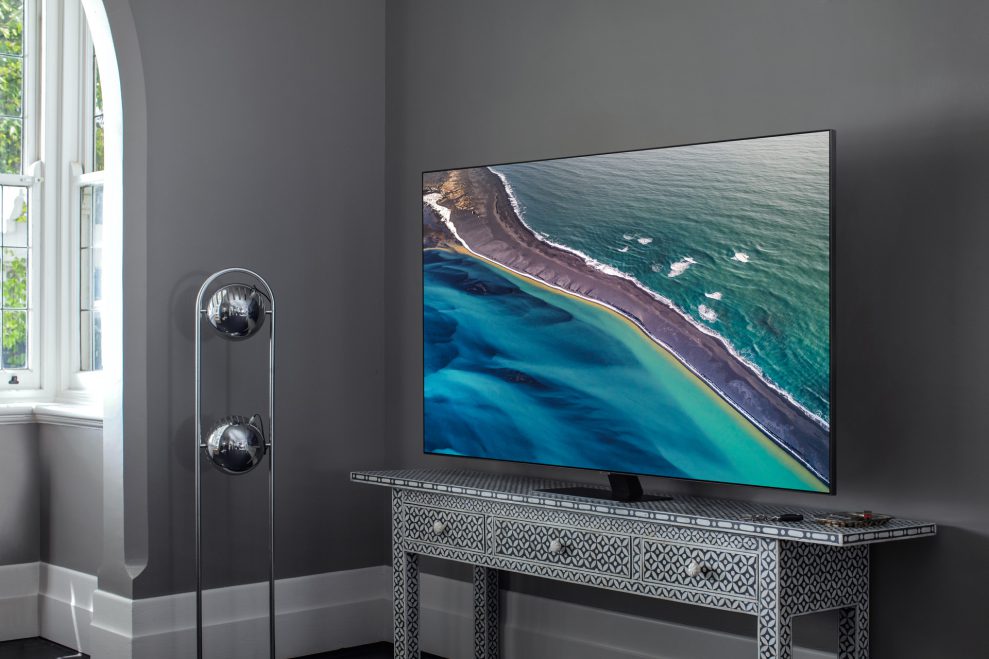
The Q80T series is available in a wide range of sizes, from 49 “and up to 85”. In this test, we have taken a closer look at the 65 ”and 85” model.
Samsung Q80T is characterized by a slim and sleek design, with a base that is both narrow and flat. It has only a thin frame around the screen, where the image goes almost completely to the edges. For a direct LED TV to be, it is also relatively slim in depth: Slightly thicker than the thinnest OLED screens, but nothing that bothers.
If you are familiar with Samsung’s more expensive models, there will be a couple of features that excel with its absence on the Q80T: It only has a standard wall mount (not so-called No-Gap), and also has no separate junction box. Therefore, the installation becomes more of the traditional kind, with wires hanging down. However, Samsung has made it possible to route cables down through the base.
Caption: The Q80T has to do without Samsung’s practical wall mount and junction box, and is therefore best suited for standing on the bench. However, it has grooves to guide the cables in a practical way.
Ease of use and features
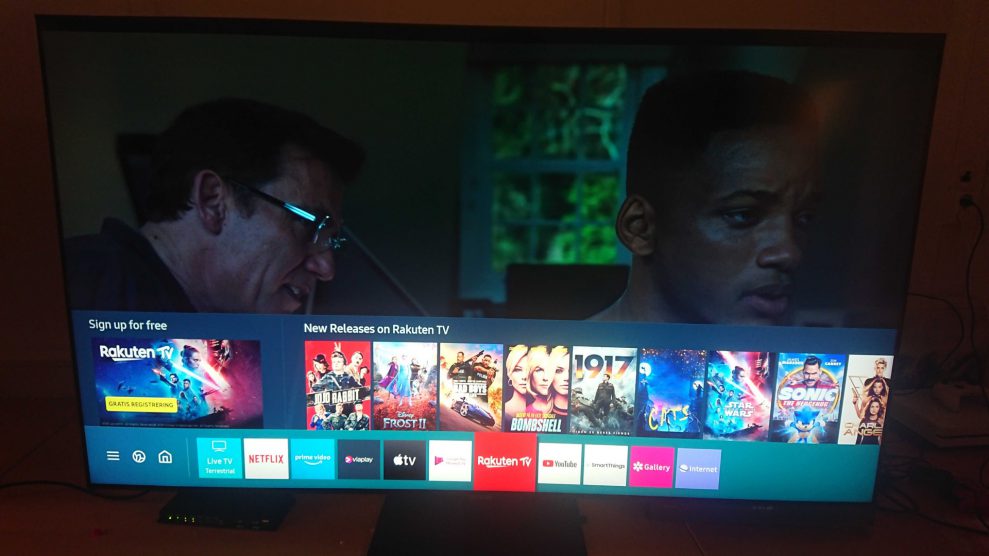
The Samsung Q80T may belong to the middle class among this year’s models, but when it comes to features, it is actually close to the top models.
The selection of streaming services is very good: With both Netflix, Apple, Amazon, HBO, Rakuten and soon also Disney +, there is plenty of content to frolic in.
The Tizen user interface is one of our favorites in smart TV. This year’s version has sharper graphics and better organized menus. The TV is super easy to set up using your mobile, and the menu bar makes it easy to find different types of content. You can customize your own menu bar with the apps you use the most.
Another novelty on the 2020 models is the Smart View feature, which allows you to display your mobile screen next to the TV content. It is even possible to listen to the other “screen” via the headphone output!
The Q80T also has Ambient Mode, which is Samsung’s smart screen saver. When the screen is in standby, it can display everything from family photos to weather information, or colors and graphics that blend in with the surroundings.
Of course, the Q80T supports HDR video, including the open HDR10 + format with dynamic metadata. On the other hand, it has to do without Dolby Vision, which Netflix, among other things, uses on much of its HDR content. Samsung is now the only major TV manufacturer that does not support the Dolby format.
The Samsung Q80T also boasts HDMI 2.1 on one of the inputs. It supports 4K / 120p Variable Refresh Rate (VRR) and Auto Low Latency Mode (ALLM). It bodes well for future compatibility with next-generation gaming consoles Playstation 5 and Xbox Series X.
The Q80T also has a dedicated game mode, with a record low delay. We measured so-called input layers down to 5 milliseconds!
Image Quality
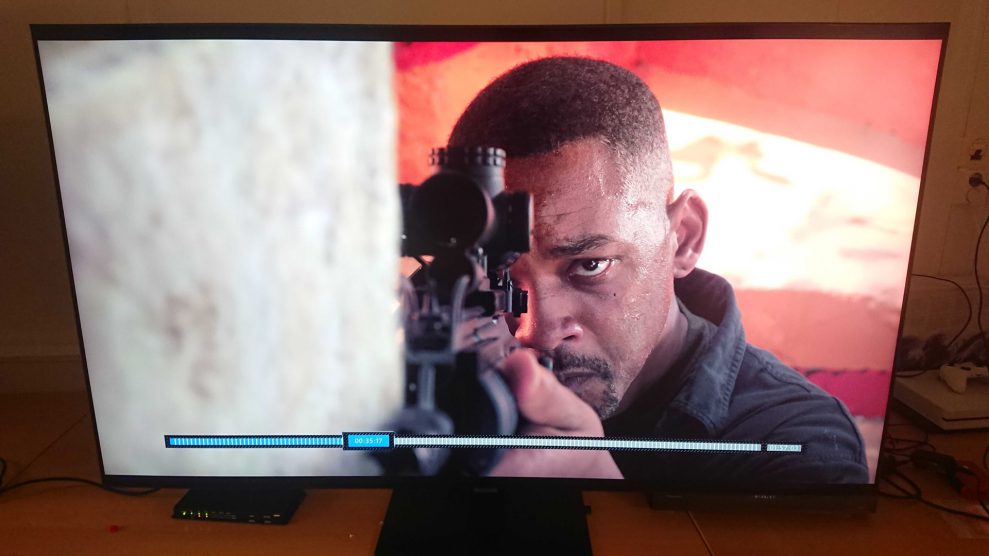
As we mentioned in the introduction, the Q80T is the entrance ticket to so-called direct LED TV from Samsung this year. All the less expensive models, including the design model The Frame, must cope with edge LEDs. And we should not underestimate the difference this makes to the image quality: During the test, we had The Frame standing next to it. And even though this year’s model has received a clear boost, it cannot match the contrast from the Q80T!
With the Samsung screens side by side, there is no doubt that both look great on standard TV content. Both news, sports and entertainment look sharp and delicious, with a smooth and clean color reproduction, plus a wide viewing angle. Both models also do a good job of scaling up HD content to razor-sharp 4K. No wonder, since they both use the same video processor (Quantum Processor 4K).
It is only when we challenge the two Samsung monitors with modern HDR content (video with higher contrast and wider color spectrum) that the differences begin to become prominent. Much of the content from Netflix, Amazon, Disney as well as 4K Blu-ray is now rendered in HDR format, which really pushes the TV’s performance to the limit.
Edge LED screens such as The Frame have a major handicap on HDR content, because the static backlight puts a damper on the contrast. The screen simply cannot reproduce the darkest and lightest shades at the same time. The contrast range is simply too large, and many visual details are lost. Here, the Q80T with direct LED backlighting has a great advantage, as it can reproduce greater contrast differences from scene to scene.
Extremely strong contrasts
With the 4K movie Gemini Man in the Blu-ray player, there is a strikingly big difference between The Frame and the Q80T. The action film starring Will Smith offers many colorful scenes in daylight as well as in the dark. And the general impression is that the Q80T has significantly more impact! Here there is a real spark in the colors, in addition to the darker scenes getting a completely different depth and richness of detail. The Q80T has plenty of brightness enough to watch TV in broad daylight, while at the same time being able to bring out the darkest shades in a dark scene. The contrast is simply amazing!
The picture on The Frame, by comparison, looks quite flat, and does not give the same feeling of depth in dark scenes. Bright objects on the screen, such as flames and explosions, also do not get the same vivid glow as on the Q80T. No doubt: Here the picture experience clearly goes in favor of direct LED.
4K vs 8K
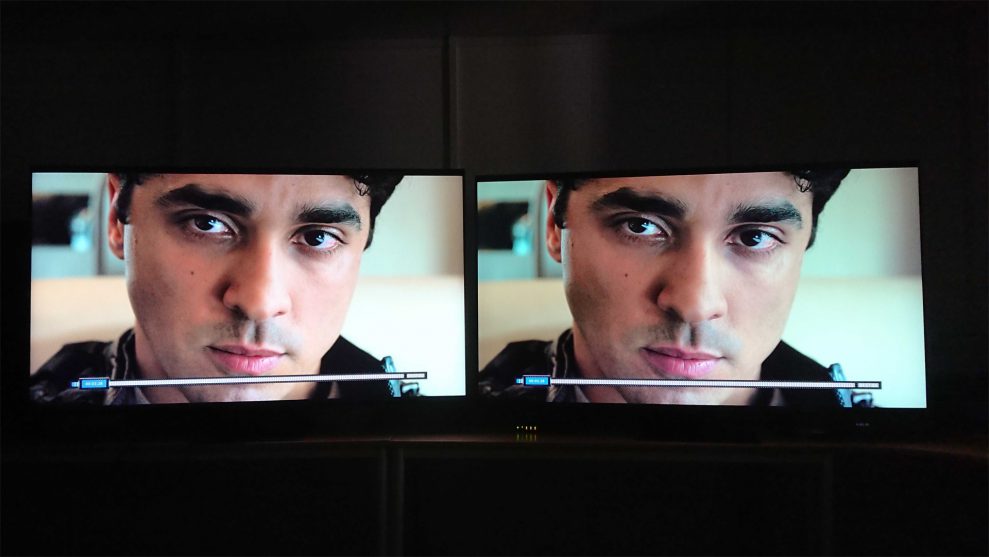
The Q80T is actually so good, that it was tempting to compare with the far more expensive Q800T that we also have standing. This 8K screen costs twice as much as the Q80T in 65 ”, which should indicate a raw part and pure declassification! But it is not quite as black and white.
The 4K screen Q80T obviously does not match the razor-sharp and super-smooth image from the 8K model. Here, the Q800T is simply superior. But when it comes to contrast, color reproduction and overall image experience, there are actually more similarities than differences between the two. Both TVs offer a very nice, nuanced color reproduction that is also well preserved at a sharper viewing angle. In addition, they actually have about the same level of blackness. Although the Q80T has slightly fewer individual zones, with a slightly more visible “halo” effect from the backlight, the difference is far smaller than we had thought beforehand. Not bad for a TV for 20,000 kroner!
The only thing that hampers the contrast a bit is that the Q80T has a slightly shinier front glass than the Q800T, and therefore is more sensitive to light reflections and “mirroring” of the room. But as long as you take precautions with curtains in front of the windows, this does not have to be a big problem. Alternatively, you can consider more expensive models such as the Q90T and Q95T – which come equipped with Samsung’s super matte Ultra Black filter.
From 65” to 85”!
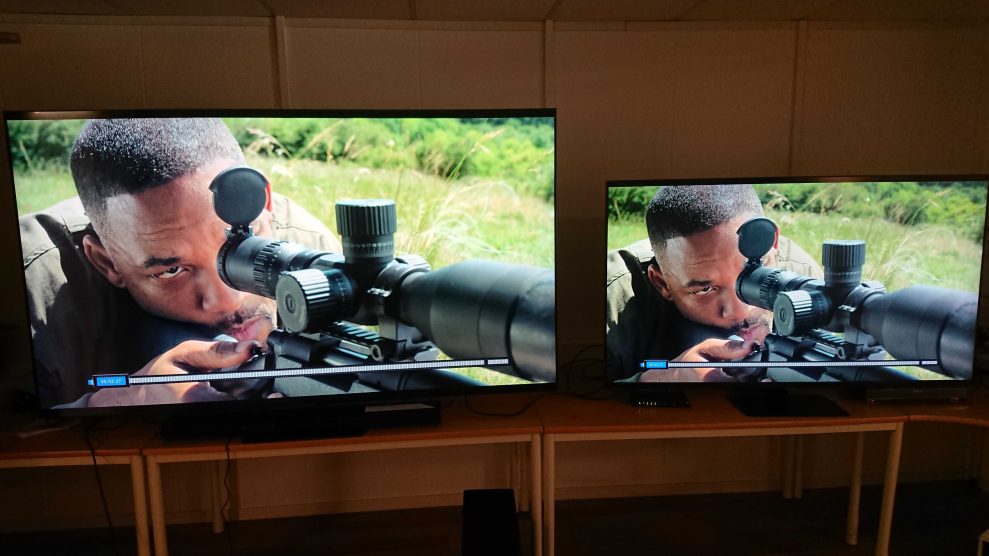
In addition to the 65 ”version of the Q80T, we have also checked out the 85-inch in the same series. We do this to make sure that the performance is more or less the same between the different models. In addition, we do it because 85 ”is raw!
QE85Q80T has the same design on the outside, but is definitely a solid TV. With its 85 inches, it has almost 30% larger image area than 75 “, and is more than 70% larger than 65” that we have standing next to it. The huge screen fills the entire field of view with the entertainment you want to see. Nevertheless, it is relatively easy to place, thanks to the center-mounted plinth.
Our general impression of the 85 ”Q80T is that it has the same overall image quality as the 65”. However, when it comes to PICTURE EXPERIENCE, the little brother goes a long way! It’s almost like going from a small village cinema to a pure IMAX show!
The razor-sharp 4K resolution really comes into its own with such a large image area. In addition, the direct LED backlight helps the screen maintain good contrast and brightness, evenly distributed throughout the screen. Viewing angle and color reproduction appear very good, and so do the smooth movements.
We did not really experience any particular disadvantages with the larger Q80T model, except for one thing: the relatively shiny front glass will probably be extra noticeable here, given the massive image area. Therefore, it is important to take certain precautions with where you place the TV in relation to windows and other light sources.
Sound quality
The Samsung Q80T comes with some interesting features on the sound side, including Object Tracking Sound. This feature uses an extra set of speakers, as well as digital audio processing to create a larger and more vivid sound image. The TV analyzes the audio signal and distributes the sound effects to provide a more realistic surround effect.
The Samsung screen actually provides excellent sound on its own: here there is good clarity in the voices, as well as nice fullness in the bass. The extra speakers also help to make the sound picture bigger and wider, in that the sound spreads more evenly around the entire TV, and not just from the bottom. The sound that comes out matches better with what we see on the screen. This is experienced as a clear advantage, especially with the huge 85 ”version!
Samsung Q Symphony: Soundboard and TV in interaction
Although the Samsung Q80T has relatively good TV sound, it will of course get good traction from a proper soundboard with subwoofer – preferably with Atmos 3D sound. Here it is worth mentioning that you can now extract the audio signal from the TV in high quality via the HDMI eARC connector.
If you choose a new 2020 model soundboard from Samsung, you can also use the new feature Q Symphony: This utilizes the TV’s own speakers in combination with the soundboard, to create an even larger sound image.
In connection with the test, we also borrowed a Samsung Soundbar Q800T soundboard, so we could check out Q Symphony. And the result is actually quite interesting.
A serious soundboard like the Q800T naturally gives a big boost in itself. Voices, music and sound effects get a completely different clarity, fullness and authority, not least thanks to the wireless subwoofer.
When we switch to Q Symphony, we do not notice any particular increase in sound quality, but there is definitely an increase in quantity! The sound image becomes wider and louder, and gives a clearer surround effect. This was especially noticeable on soundtracks with Dolby Atmos: here the soundboard uses the TV’s top-mounted speakers as built-in “height channels”, which gives a noticeably greater 3D effect. There also seems to be good mutual synchronization between the different speakers.
However, we had to be careful not to turn up the volume too much: the built-in TV speakers clearly sound the pressure at high sound levels, with distortion and resonance that colors the sound image. This occurs at a point where the soundboard still has some power left over. Q Symphony is therefore no substitute for extra, full-fledged separate surround speakers, but can still be a pretty fun and useful feature, as long as it is used sparingly.
Conclusion
The Samsung Q80T is emerging as a highly interesting candidate in the premium class: It costs a little more than the budget models, but offers great visual benefits. The Samsung screen is as created to watch demanding movies and series in HDR quality: The direct LED backlight contributes to superb contrast. In addition, this model scores well on equipment and connectivity options. If you drool on Samsung’s rawest high-end models, but do not want to pay a fortune, the Q80T is clearly a good buy. We are still at the beginning of the TV year 2020, but one thing is for sure: Here the competitors have got a TV to work on!

We think
The Samsung screen serves a sharp and contrast-rich image experience that comes close to the high-end models, at a far more affordable price. An excellent purchase! The Q80T has to do without fancy features such as No Gap wall mount and One Connect junction box, and the shiny front glass reflects a lot of light.
1299 €
Specifications
- Size / type: 65 ”4K QLED-LCD
- Resolution: 3840×2160 (4K Ultra HD)
- Operating system: Tizen
- Inputs: 4 HDMI (1 x 2.1), 3 USB
- Outputs: Optical digital audio output
- HDR: HDR10 +
- Other: OTS speaker system
- Web: samsung.com/no
